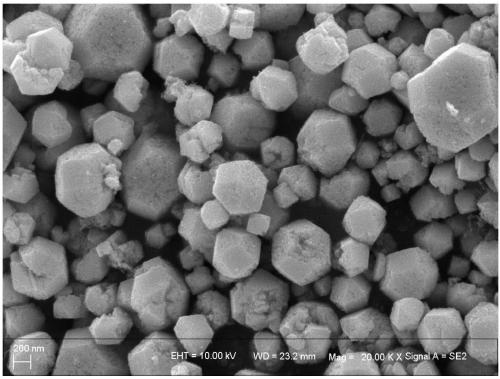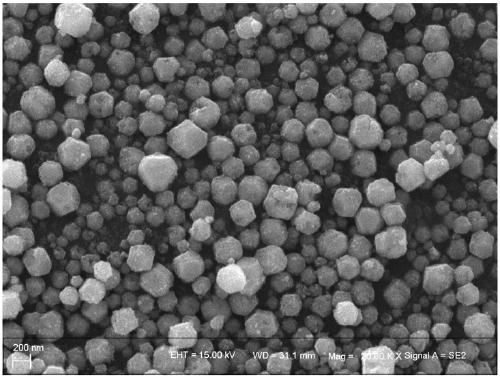Synthetic method of zinc stannate nanomaterial for n-type transparent semiconductor film
A technology of nano-zinc stannate and synthesis method, which is applied in the fields of nanotechnology, tin compounds, and nanotechnology for materials and surface science, can solve problems such as affecting the light transmittance of nanocrystalline films, and achieve high electrical conductivity, high Effect of Electron Mobility
- Summary
- Abstract
- Description
- Claims
- Application Information
AI Technical Summary
Problems solved by technology
Method used
Image
Examples
Embodiment 1
[0034] A kind of synthetic method for the nano zinc stannate material of n-type transparent semiconductor film, the steps are as follows:
[0035] 1) Preparation of molar ratio Zn:Sn=2:1 precursor
[0036] Weigh SnCl 4 12.547g, according to the ratio of each component of the above precursor solution according to SnCl 4 The amount to determine the ZnCl 2 amount. ZnCl 2 Easy to deliquescence, weighing must be fast, called ZnCl 2 13.12g and dissolved with an appropriate amount of deionized water (the amount of deionized water should not exceed the quality of the final precursor solution, generally enough to dissolve ZnCl 2 can), after stirring and cooling down to room temperature, the SnCl 4 with ZnCl 2 Quickly mix the aqueous solution, stir to dissolve and mix evenly and cool down to room temperature, then add an appropriate amount of deionized water (the final solution quality is determined according to the ratio of the components of the above-mentioned precursor solutio...
Embodiment 2
[0041] A kind of synthetic method for the nano zinc stannate material of n-type transparent semiconductor film, the steps are as follows:
[0042] 1) Preparation of molar ratio Zn:Sn=2:1 precursor
[0043] Consistent with embodiment 1 scheme
[0044] Weigh SnCl 4 12.55g, according to the ratio of each component of the above precursor solution according to SnCl 4 The amount to determine the ZnCl 2 amount. ZnCl 2 Easy to deliquescence, weighing must be fast, called ZnCl 2 13.12g and dissolved with an appropriate amount of deionized water (the amount of deionized water should not exceed the quality of the final precursor solution, generally enough to dissolve ZnCl 2 can), after stirring and cooling down to room temperature, the SnCl 4 with ZnCl 2Quickly mix the aqueous solution, stir to dissolve and mix evenly and cool down to room temperature, then add an appropriate amount of deionized water (the final solution quality is determined according to the ratio of the compone...
Embodiment 3
[0049] A kind of synthetic method for the nano zinc stannate material of n-type transparent semiconductor film, the steps are as follows:
[0050] 1) Preparation of molar ratio Zn:Sn=2:1 precursor
[0051] Consistent with embodiment 1 scheme
[0052] Weigh SnCl 4 12.547g, according to the ratio of each component of the above precursor solution according to SnCl 4 The amount to determine the ZnCl 2 amount. ZnCl 2 Easy to deliquescence, weighing must be fast, called ZnCl 2 13.12g and dissolved with an appropriate amount of deionized water (the amount of deionized water should not exceed the quality of the final precursor solution, generally enough to dissolve ZnCl 2 can), after stirring and cooling down to room temperature, the SnCl 4 with ZnCl 2 Quickly mix the aqueous solution, stir to dissolve and mix evenly and cool down to room temperature, then add an appropriate amount of deionized water (the final solution quality is determined according to the ratio of the compo...
PUM
| Property | Measurement | Unit |
|---|---|---|
| particle diameter | aaaaa | aaaaa |
| particle diameter | aaaaa | aaaaa |
Abstract
Description
Claims
Application Information
 Login to View More
Login to View More - R&D
- Intellectual Property
- Life Sciences
- Materials
- Tech Scout
- Unparalleled Data Quality
- Higher Quality Content
- 60% Fewer Hallucinations
Browse by: Latest US Patents, China's latest patents, Technical Efficacy Thesaurus, Application Domain, Technology Topic, Popular Technical Reports.
© 2025 PatSnap. All rights reserved.Legal|Privacy policy|Modern Slavery Act Transparency Statement|Sitemap|About US| Contact US: help@patsnap.com



